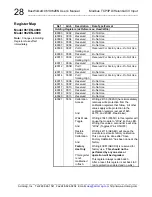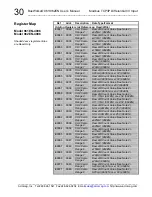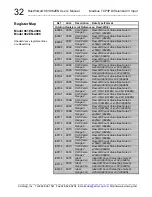
BusWorks® 961/962EN User’s Manual Modbus TCP/IP Differential I/V Input
___________________________________________________________________
_______________________________________________________________________________________
Acromag, Inc. Tel:248-624-1541 Fax:248-624-9234 Email:
http://www.acromag.com
39
LED Indicators:
RUN (Green) -
Constant ON if power is on. Continuous flashing ON/OFF
indicates unit is in “wink” ID mode.
ST (Yellow) –
Blinks ON/OFF in default communication mode. Stays ON
if an input is out of range.
LINK (Green) –
Indicates Ethernet
link
status (ON if auto-negotiation has
successfully established a connection).
ACT (Yellow)
– Indicates Ethernet
activity
(Ethernet connection is
busy/traffic is present).
Controls:
Reset/Default Address Switch:
This momentary toggle switch is
located on the front panel and is used to either reset the module
(toggle right), or cause the module to assume a default IP address
(toggle left). Module address is initially set to 128.1.1.100 at the
factory, or may be preset by the user. This switch can also be used to
restore the module to its initial factory configuration by holding this
switch in its default position while powering up the unit (see “Getting
Out Of Trouble” in the Troubleshooting section for more information).
The minimum cable required for full operation of this device is Category 5.
The term “Category” refers to classifications of UTP (Unshielded Twisted
Pair) and STP (Shielded Twisted Pair) cables. There are 3 main categories
of cable – Category 3, Category 4, and Category 5. The differences in
classification is found in their electrical performance and this is documented
in the TIA/EIA 568-A standard.
This device is designed for use in harsh industrial environments. Acromag
recommends the use of shielded cable when wiring to this device. Select
STP (Shielded Twisted Pair) cable rather than UTP (Unshielded Twisted
Pair). The use of shielded cable will help protect the data being transmitted
from harmful EMI (Electromagnetic Interference) and RFI (Radio Frequency
Interference). It will also help to lower your radiated emissions by keeping
the cable from emitting EMI and RFI.
There are two types of cable conductors: solid cable and stranded cable.
Stranded cables are more flexible than solid cables. But since attenuation is
higher for stranded cables than solid conductor cables, these are generally
reserved for short runs and patch applications less than 6 meters.
Currently there are two types of shielding employed in Category 5 STP
cable: single-shielded and double-shielded. Both of these cables have the
same core and jacket as UTP cables, but also include a thin foil outer shield
that covers all four twisted-wire pairs. Variations may include a drain wire
that encircles the outer jacket. A double-shielded version adds an outer wire
screen that surrounds the foil shield and also functions as a drain wire. The
drain wire or wire screen typically makes contact at each end of the cable
with the metal shield around special RJ45 plug connectors. This shield then
makes contact with the metal shield of shielded RJ45 sockets. The socket
shield may make direct contact with earth ground, or it may be capacitively
coupled to earth ground. In the Acromag 9xxEN modules, it makes contact
with earth ground via a high voltage capacitor and transient voltage
suppressor. In addition to separately isolating the shield, this helps to
minimize radio frequency and electromagnetic interference, and has the
added benefit of protection from ESD (Electro-Static Discharge).
Controls & Indicators
ACCESSORY
CABLES


































